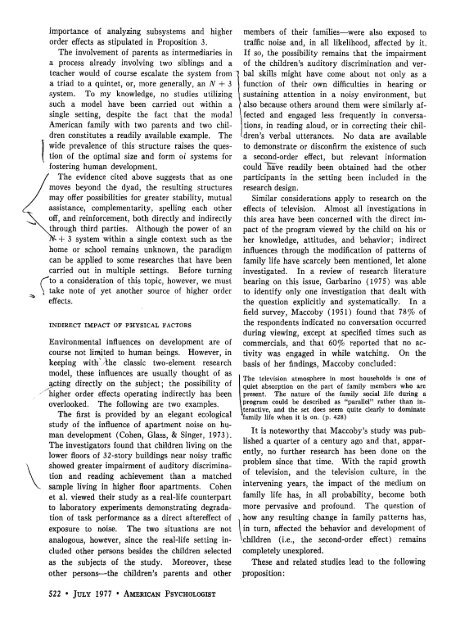Bronfenbrenner 1977
You also want an ePaper? Increase the reach of your titles
YUMPU automatically turns print PDFs into web optimized ePapers that Google loves.
importance of analyzing subsystems and higher<br />
order effects as stipulated in Proposition 3.<br />
The involvement of parents as intermediaries in<br />
a process already involving two siblings and a<br />
teacher would of course escalate the system from<br />
a triad to a quintet, or, more generally, an TV + 3<br />
system. To my knowledge, no studies utilizing<br />
such a model have been carried out within a<br />
single setting, despite the fact that the modal<br />
American family with two parents and two children<br />
constitutes a readily available example. The<br />
wide prevalence of this structure raises the question<br />
of the optimal size and form of systems for<br />
fostering human development.<br />
The evidence cited above suggests that as one<br />
moves beyond the dyad, the resulting structures<br />
may offer possibilities for greater stability, mutual<br />
assistance, complementarity, spelling each other<br />
off, and reinforcement, both directly and indirectly<br />
through third parties. Although the power of an<br />
+ 3 system within a single context such as the<br />
home or school remains unknown, the paradigm<br />
can be applied to some researches that have been<br />
carried out in multiple settings. Before turning<br />
/^to a consideration of this topic, however, we must<br />
\ take note of yet another source of higher order<br />
effects.<br />
INDIRECT IMPACT OF PHYSICAL FACTORS<br />
Environmental influences on development are of<br />
course not limited to human beings. However, in<br />
keeping with -the classic two-element research<br />
model, these influences are usually thought of as<br />
acting directly on the subject; the possibility of<br />
-' higher order effects operating indirectly has been<br />
overlooked. The following are two examples.<br />
The first is provided by an elegant ecological<br />
study of the influence of apartment noise on human<br />
development (Cohen, Glass, & Singer, 1973).<br />
The investigators found that children living on the<br />
lower floors of 32-story buildings near noisy traffic<br />
showed greater impairment of auditory discrimination<br />
and reading achievement than a matched<br />
. sample living in higher floor apartments. Cohen<br />
et al. viewed their study as a real-life counterpart<br />
to laboratory experiments demonstrating degradation<br />
of task performance as a direct aftereffect of<br />
exposure to noise. The two situations are not<br />
analogous, however, since the real-life setting included<br />
other persons besides the children selected<br />
as the subjects of the study. Moreover, these<br />
other persons—the children's parents and other<br />
522 • JULY <strong>1977</strong> • AMERICAN PSYCHOLOGIST<br />
members of their families—were also exposed to<br />
traffic noise and, in all likelihood, affected by it.<br />
If so, the possibility remains that the impairment<br />
of the children's auditory discrimination and ver-<br />
'1 bal skills might have come about not only as a<br />
j function of their own difficulties in hearing or<br />
1 sustaining attention in a noisy environment, but<br />
| also because others around them were similarly af-<br />
Ifected and engaged less frequently in conversations,<br />
in reading aloud, or in correcting their children's<br />
verbal utterances. No data are available<br />
to demonstrate or disconfirm the existence of such<br />
a second-order effect, but relevant information<br />
could Tiave readily been obtained had the other<br />
participants in the setting been included in the<br />
research design.<br />
Similar considerations apply to research on the<br />
effects of television. Almost all investigations in<br />
this area have been concerned with the direct impact<br />
of the program viewed by the child on his or<br />
her knowledge, attitudes, and behavior; indirect<br />
influences through the modification of patterns of<br />
family life have scarcely been mentioned, let alone<br />
investigated. In a review of research literature<br />
bearing on this issue, Garbarino (1975) was able<br />
to identify only one investigation that dealt with<br />
the question explicitly and systematically. In a<br />
field survey, Maccoby (1951) found that 78% of<br />
the respondents indicated no conversation occurred<br />
during viewing, except at specified times such as<br />
commercials, and that 60% reported that no activity<br />
was engaged in while watching. On the<br />
basis of her findings, Maccoby concluded:<br />
The television atmosphere in most households is one of<br />
quiet absorption on the part of family members who are<br />
present. The nature of the family social life during a<br />
program could be described as "parallel" rather than interactive,<br />
and the set does seem quite clearly to dominate<br />
family life when it is on. (p. 428)<br />
It is noteworthy that Maccoby's study was published<br />
a quarter of a century ago and that, apparently,<br />
no further research has been done on the<br />
problem since that time. With the rapid growth<br />
of television, and the television culture, in the<br />
intervening years, the impact of the medium on<br />
family life has, in all probability, become both<br />
more pervasive and profound. The question of<br />
how any resulting change in family patterns has,<br />
in turn, affected the behavior and development of<br />
children (i.e., the second-order effect) remains<br />
completely unexplored.<br />
These and related studies lead to the following<br />
proposition:


